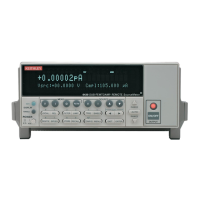Sweep Operation 9-13
Setting delay
Generally, the time duration spent at each step (or point) of a sweep consists of the source
delay and the time it takes to perform the measurement (NPLC setting).
The source delay is part of the SDM cycle and is used to allow the source to settle before the
measurement is made. See Section 5, Source-delay-measure cycle for details.
The total time period of the source delay could include an auto-delay and/or a user pro-
grammed delay. With auto-delay enabled, 1ms of delay is used. The user programmable source
delay adds 0000.0000 to 9999.9990 seconds of delay. See Section 3, Source delay to set these
delays.
Additional delay for a sweep is available by using the trigger delay. This user-specified
delay (0000.0000 to 9999.99990 seconds) occurs before each SDM cycle (device action) of the
sweep. Thus, the trigger delay is executed before each new source-point in the sweep. See
Section 10, Trigger model and Configuring triggering to set trigger delay.
NOTE For linear staircase, log staircase, and custom sweeps, source delay, trigger delay,
and NPLC settings are global and affect all sweep points simultaneously. For source
memory sweep only, both the source delay and NPLC settings can be set to different
values for each point in the sweep.
Trigger count and sweep points
The trigger count and number of sweep points should be the same or multiples of one
another. For example, with five sweep points and a trigger count of 10, the sweep will run
twice. See Section 10 for details on trigger count.
Performing sweeps
Procedures for the various sweep types are covered below.
NOTE The following procedure assumes that the SourceMeter is already connected to the
DUT as explained in Section 2.
WARNING Hazardous voltages (>30V rms) can appear on the selected INPUT/
OUTPUT LO or Remote PreAmp terminals when performing fast pulse
sweep operations. To eliminate this shock hazard, connect the LO terminal
to earth ground. The ground connection can be made at the chassis ground
screw on the rear panel or to a known safety earth ground.

